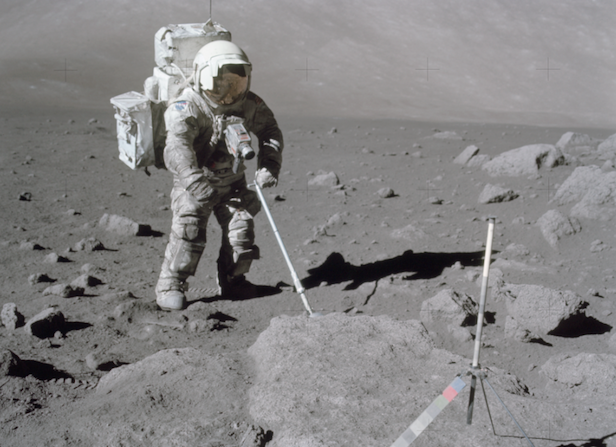
“Dust is the number one concern in returning to the Moon”
—John Young, Apollo 16
Moon dust can be a real nuisance. During the Apollo missions, the tiny particles stuck to everything and could simply not be wiped off. The dust wore into spacesuits and boots—it even ate into the suits’ metal seals. After just three lunar EVAs the spacesuits were essentially ruined and could not be reused. Moreover, the dust clogged air vents, causing equipment to overheat. When the dust particles entered the astronauts’ nasal passages, it caused sneezing and irritation. The dust followed astronauts into the lunar module and then into the command module that returned them to Earth.
To prepare for journeys to other worlds, NASA commissioned a study to investigate the dust’s effect on human health. The work involved examining the tiniest of dust particles—those that could potentially enter human lungs. I was part of the team that performed a series of experiments with the soil samples brought back from the Apollo missions.
The six Apollo teams returned a total of 382 kilograms (842 pounds) of precious lunar samples—national treasures—retrieved from six different exploration sites. Most of the moon rocks are stored at Johnson Space Center in Houston. The Lunar Sample Laboratory Facility in Building 31-N was completed in 1979 to provide permanent storage for extraterrestrial samples such as these.
Building 31 North is one of the few buildings on earth constructed under Class 100 standards—it is a structure that can withstand 1,000 years of water submersion—a capability recently tested by Hurricane Harvey.
To protect the samples from earthly contamination, they are kept in a pressurized atmosphere of pure nitrogen. People working inside the facility wear cleanroom suits, while all materials entering the lab are screened for any potential contaminants.
Before going in, people must remove all jewelry, watches, and metal objects. Getting to this point requires a background check and a security clearance. Nothing is foolproof, however, as fools, too, can be ingenious. In 2002, interns working at the Johnson Space Center stole 101 grams of moon rocks (they were attempting to sell them to a Belgian collector, who, when his suspicions were aroused, tipped off the FBI).
For a scientist, gaining access to lunar samples requires months of time and mountains of paperwork. About 50 proposals for lunar samples are approved each year, most for less than one gram. I had the privilege of working with 200 grams.
***
Alan Shepard and Ed Mitchell touched down in Fra Mauro, the original target of ill-fated Apollo 13, a site chosen by a committee of scientists for its scientific value. Upon stepping down from the lunar module, Shepard’s first task was to collect a “contingency sample.” In the event the landing crew had to abort the EVA, at least they’d have a piece of Fra Mauro for scientists to study. Edgar Mitchell commented, “That was high on the geologists’ priority list. ‘Never forget the contingency sample.’ Always double bugging us that we had the contingency sample. It became kind of an in-house joke, because they were so insistent on that, almost to the exclusion of everything else.”
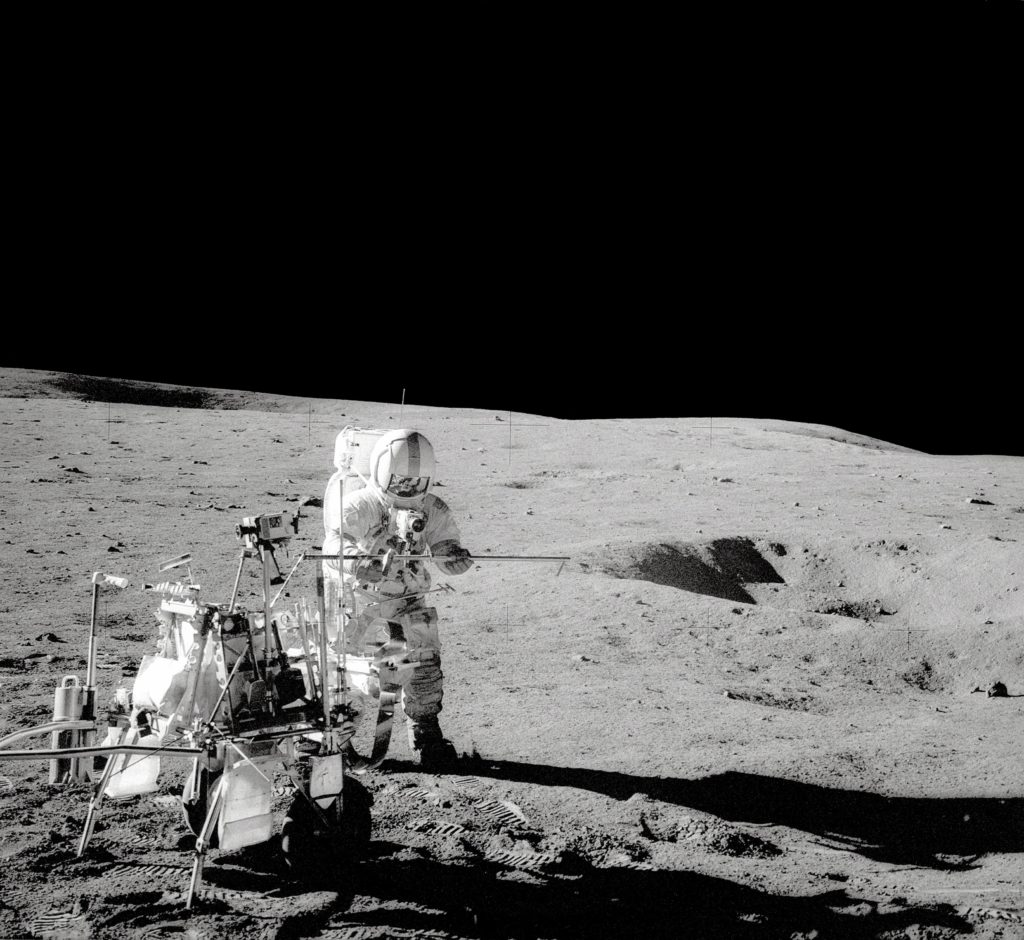
Alan Shepard stands by the Modular Equipment Transporter, a cart for carrying around tools, cameras, and sample cases on the lunar surface.
Unlike the soil on Earth that is formed through the action of oxygen, humidity, wind, and an array of biological processes, lunar soil is the result of mechanical pulverizing, courtesy of the continuous impact of micrometeorites and bombardment by interstellar charged atomic particles. The soil’s iron content makes it magnetic.
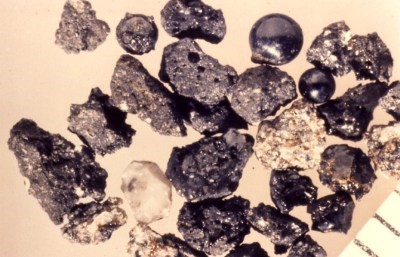
“Moondust is strange stuff,” explains Professor Larry Taylor, director of the Planetary Geosciences Institute at the University of Tennessee. “Each little grain of moondust is coated with a layer of glass [the result of the high-temperature impact] only a few hundred nanometers thick—1/100th the diameter of a human hair.” Upon examining the coating through a microscope, Taylor and his colleagues discovered “millions of tiny specks of iron suspended in the glass like stars in the sky.”
Image credit: Larry Taylor
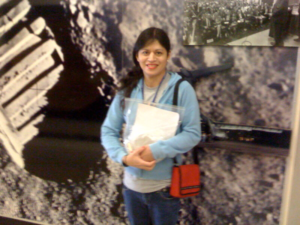
The author with a “shopping bag” containing the lunar sample. Image courtesy of Louise Riofrio.
I took possession of 14003,96 in a plastic “shopping bag,” packed along with its identifying paperwork. This 200-gram piece of the Moon had waited unopened in a vault four decades. Because much of the information about the lunar samples has been lost, including the exact manner in which samples were packaged, no one knew what to expect inside.
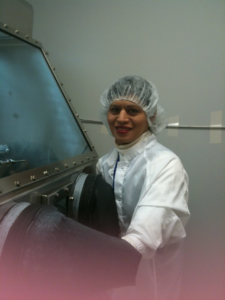
My fashion statement as I performed the delicate sample-handling work was a white cap and bunny suit. Image courtesy of Louise Riofrio.
All work done with lunar samples is conducted in a nitrogen atmosphere, inside a glove box within a cleanroom. Anything going in or out of the glovebox must pass through an airlock, as if passing into the realm of space.
Within the shopping bag was a silver aluminum container shaped like a flying saucer, sealed with 16 bolts. I needed to unscrew each bolt while working within the thick rubber gauntlets of the glovebox. The experience actually had much in common with being on EVA. Upon removing the lid, I found three layers of heat-sealed plastic bags, one inside another, which had to be individually cut open. Within these was another metal container. Opening the final lid, I had my first up-close look at the rarefied stuff.
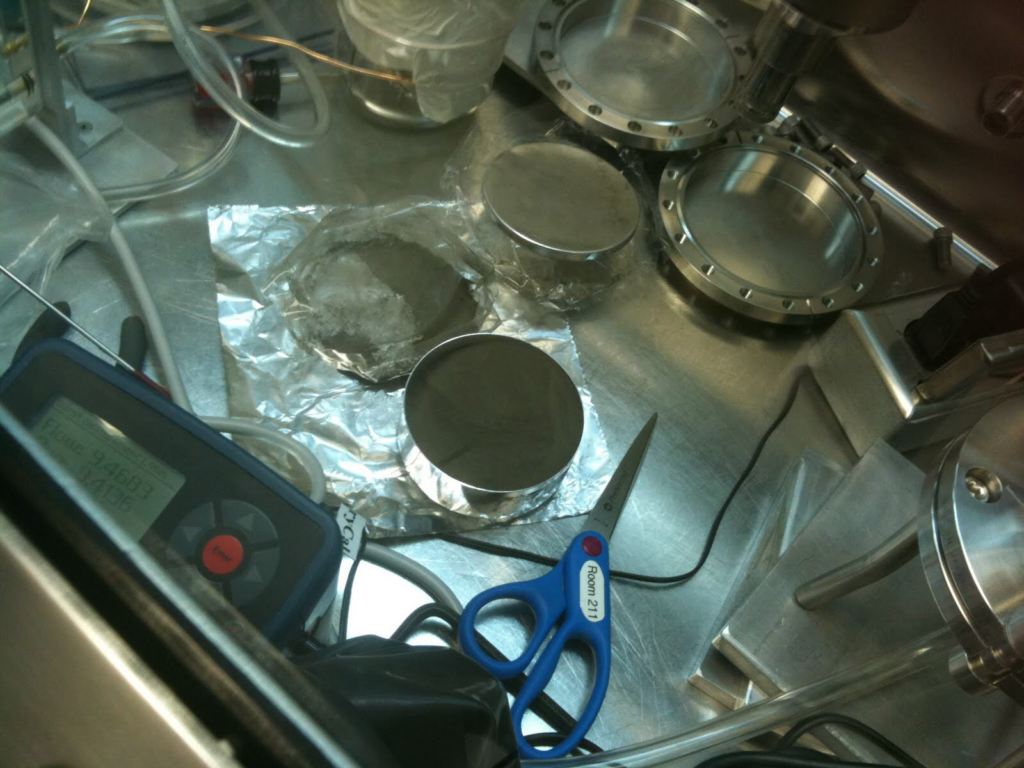
The opened sample inside the glovebox.
The lunar regolith is like no soil on Earth, having been exposed for billions of years to the elements of space without the benefit of a protective atmosphere. Under a microscope the particles appear jagged and twisted. The rock has been melted into glass, forming alien-looking shapes. The glassy particles form microscopic but highly abrasive hooks that cling to everything and grind down anything with which it comes into contact.
For a scientist seeking knowledge, the lunar soil is treasure greater than gold. Its composition tells us mush about the origin and history of the Moon and our solar system. Studies of lunar samples led to today’s popular theory that the Moon is a daughter of the Earth, torn free by a collision with another giant object. The titanic collision left a ring of large fragments orbiting the Earth, which eventually coalesced to form the Moon.
The Moon formed much closer to Earth than it is today, and it has since been slowly drifting away. We can measure this slow drift thanks to the laser reflectors left behind by other Apollo astronauts.
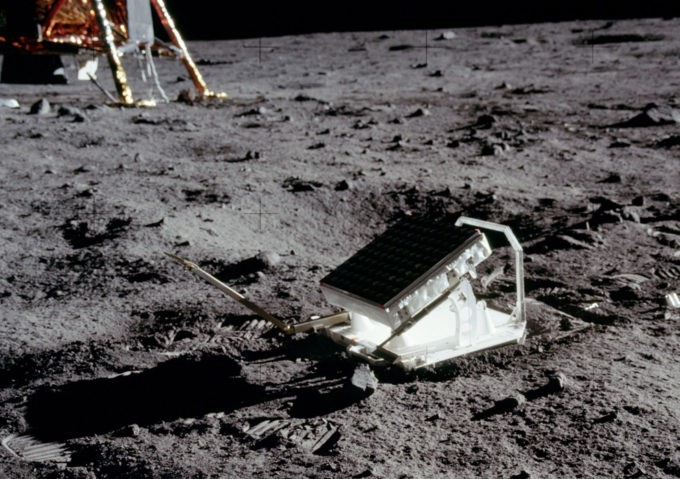
Lunar Laser Ranging Experiment, July 20, 1969.
Because the lunar soil has been bombarded by radiation from our Sun and elsewhere, it provides a record of solar variability, telling us how much the Sun’s life-giving luminosity has changed over time. The lunar soil has also been exposed to the light of nearby supernovae, which can also be studied as it, too, is a record of these unimaginably powerful exploding stars that have also singed the Earth.
Thanks to its composition, the lunar regolith is also a potential source of fuel, air, water, and other valuable resources. Each cubic meter of soil contains nearly half a liter of water. The concentration of water is likely to be greater near the lunar poles, where the soil is forever shaded from the Sun. H2O, of course, can be broken down into its constituent elements, hydrogen for rocket fuel and oxygen for human consumption. Harvesting such resources on the Moon, of course, would be tremendously more efficient than hauling these elements from Earth. The lunar soil can also be exploited for shielding, construction, and even 3D printing. The Moon is indeed a veritable bounty for future explorers of the solar system.
But before we get to that promising future, we’ve first got to get back to the dust. By experimenting with lunar dust, we’ve discovered ways to manage its many hazards. We’ve learned ways of isolating the smallest particles for experiments. We’ve investigated the use of biotechnology to separate out the iron and other minerals. By solving critical dust-related problems, such experiments bring us closer to working on the Moon with greater comfort, convenience, and most importantly, safety.
About the Author
Louise Riofrio became fascinated by science while watching space flights on television. At age 16 Riofrio was studying physics at a top university. While studying the moon as a scientist at NASA Johnson Space Center in Houston, Riofrio performed experiments with Apollo lunar samples. She is known worldwide for her theories about light, and has lectured before scientific conferences across the globe. Riofrio is the author of the popular book, The Speed of Light.



